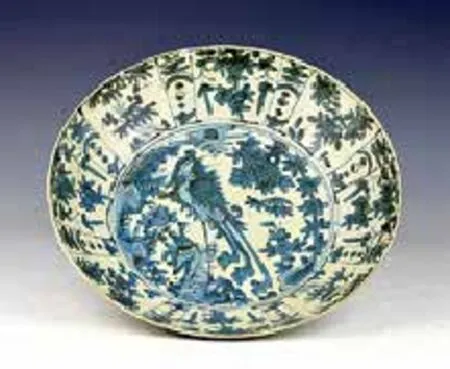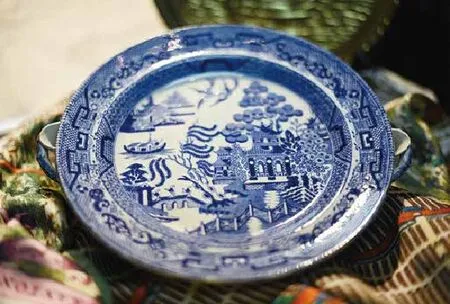漂洋过海的中国蓝
2016-05-02
漂洋过海的中国蓝


从 18世纪至今,欧洲最受欢迎的瓷器格调之一就是中国的青花蓝白风格,这种风格几乎被所有的西方陶艺制作商仿制,深得王公贵族喜爱。
青花瓷最早在唐宋出现,但真正传至欧洲,则是在明代万历年间以后。公元 1602 年,荷兰东印度公司在海上捕获一艘葡萄牙商船——“克拉克号”,船上装有大量来自中国的青花瓷器,因不明瓷器产地,欧洲人把这种瓷器命名为“克拉克瓷”。
16世纪东西方海上航路开通,双方从此开始了直接、持续和大规模的贸易交往。克拉克瓷是中西贸易中最早出现的成批量的外销瓷种类,其特点是宽边,在盘、碗的口沿绘分格及圆形开光的山水、人物、花卉、果实等。万历克拉克青花盘使用浙料绘画,有翠蓝、灰蓝、淡蓝几种色调,画师们熟练地运笔,无论勾、点、染皆随心所欲,自然洒脱。
在所有西方所知的瓷器风格中,青花“柳树纹饰”排名最高。据说这种风格最早是 1790 年前后由乔夏·斯波德从一种被称为“满大人”的中国原始风格沿袭而来。“满大人”是西方人对外销瓷器上描绘的清装人物的称呼,他们通过陶瓷装饰来对他们印象中的中国进行报道,形象生动地向人们展示这一时代中国上层社会生活状况。而西方人对青花瓷的喜爱也可以从这首广为流传的儿歌中看出几分:
两只鸟儿高高飞过
一艘中国大船静静驶过
三四个行人从桥上走过
柳树枝条在岸边摇曳
不远处有一座中国寺庙
在河边静静屹立
还有一棵果实丰硕的苹果树被弯弯曲曲的篱笆包围着
Canton1840 is an initiator of mobile museums. Mr. Wen Shi, the late owner of the Canton1840 mobile museum, has been collecting forty thousand items representing Lingnan region culture and European culture in over forty years. (WeChat: canton1840)
文仕文化博物档案馆是“近代海丝文化流动博物馆”概念的创导者。前馆长文仕先生历经 40多年对珠江岭南地域文化及欧洲百年文化的搜集,收藏了近 40000 件博物馆级珍贵史料文物。(官微“canton1840”)
ORIENTAL LANDSCAPE ACROSS THE OCEANS
Text & Photos Providel by Canton1840 Translation by Leo
文图由文仕文化博物档案馆提供

From the 18th century, the favorite porcelain product in Europe was the Chinese Qinghua Lanbai (blue and white with floral decorations), a style that was
much loved by the aristocrats and copied by almost all Western artisans.
Qinghua porcelain first appeared in the Tang and Song Dynasty, but the fine wares only made it to Europe during and after the reign of Emperor Wanli of the Ming Dynasty.
Founded in 1602, the Dutch East India Company often captured Portuguese merchant vessels that were called Carracks. These vessels were often loaded with Qinghua porcelain. However, uncertain about its origins, the Dutch named it Kraak porcelain. During the 16th century, the maritime trading route between the East and West became connected. This was the beginning of direct, continuous, and large-scale trade between the two. Kraak porcelain was the earliest type of porcelain that was exported on a large scale from China to Europe. The unique designs and patterns of Kraak porcelain made it extremely popular in Europe. These plates and bowls were characterized by their width as well as depictions of landscapes, people, flowers, and fruits on surfaces and rims. Kraak porcelain were colored using Zheliao (the pigment responsible for coloring the wares), which can be divided into colours bright blue, grayish blue, and pale blue. Artisans used brushes to skillfully produce, dots, or shading that together create natural and delightful patterns.
Of all the European porcelain styles the Willow Pattern was perhaps the most revered and sought after. This style is believed to be inspired by the Mandarin series of Chinese porcelain that were imported in the 1790s by Josiah Spode. The Europeans gave the title of Mandarin to any individuals depicted in the porcelain wearing Qing Dynasty garbs. People studied the patterns and decorations on the porcelain to learn about everyday life in China as well as the trappings, activities, and various details of the Chinese upper class. In other words, the porcelain was a window through which the West learned about China. The European love for Qinghua porcelain could also be appreciated in this popular children's song∶
Two pigeons flying high, Chinese vessels sailing by. Weeping willow hanging o'er, Bridge with three men - if not four. Chinese temple, there it stands, Seems to cover all the land. Apple tree with apples on, A pretty fence to end my song.
